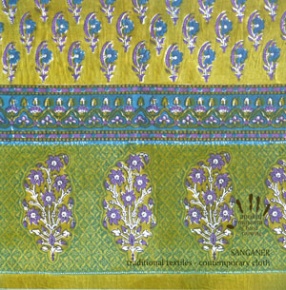Historicaly renowned for block printing, the bustling town of Sanganer evokes an almost mythical association with hand printed cloth. Home to a large community of block printers for centuries, the city remains a vital contributor to India's vibrant textile industry even though time has brought significant changes. A place where ancient traditions collide with modern concerns, Sanganer presents an interesting paradigm for the current state of the craft. As reviewed in this publication, a comparison that, in turn, the evolution of block printing in this legendary town.
Traditionally, the cohesive community of Sanganeri chhippa printers and rangrez dyers worked together in harmony using hand carved blocks, natural dyes and classic motifs. The introduction of screen printing and chemical colours in the 20th century reptured this ancient dynamic and fostered the high volume production of modern textiles. According to the 2008 Sanganer census, 423 screen printing units far exceed the 350 block printing units in both number and size which exemplifies the town's rapid transformation since 1947. This development has not only affected the role of craftspeople, but also resulted in the modification of classic designs to suit contemporary taste.
Indian artisans have always displayed an amazing resillience and hand block printing has continually adapted to market forces in India and beyond. During the 18th century, the famed Chhippa and ragrez communities of Sanganer expanded their trade by uniting to create delicately patterned and coloured muslin material for a broad-based clientele. Royal patronage fuelled domestic trade and eventually launched the work of the Sanganeri crafspeople into the international arena. The extraordinary quality of Sanganeri prints was highly prized. By the late 1950s Sanganer printers faced a drastic decline in demand for their textiles.







There are no reviews yet.